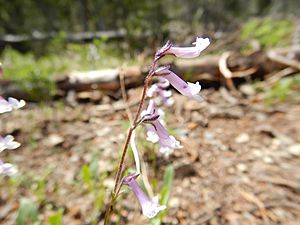Tweedy's snowlover facts for kids
Quick facts for kids Tweedy's snowlover |
|
|---|---|
 |
|
| Chionophylla tweedyi, Montana, USA | |
| Scientific classification | |
| Genus: |
Chionophila
|
| Species: |
tweedyi
|
Chionophila tweedyi, also known as Tweedy's snowlover, is a type of plant that grows year after year. It belongs to the plantain family. You can find this plant growing naturally in Idaho and Montana in the western United States.
Contents
Understanding Tweedy's Snowlover
Tweedy's snowlover has been a bit of a puzzle for plant scientists, called taxonomists. Taxonomists are like detectives who study and organize living things into groups.
How It Got Its Name
This plant was first described in 1890 by two scientists, William Marriott Canby and Joseph Nelson Rose. They named it Penstemon tweedyi to honor Frank Tweedy. He was the first person to collect a sample of this plant. The original sample collected by Tweedy is kept at Harvard University.
A few months later, in 1900, another scientist named Louis Forniquet Henderson decided that Tweedy's snowlover should be moved to a different group, called the Chionophila genus. He found it very tricky to classify this plant. He even thought about creating a brand new group just for it!
Henderson carefully compared Tweedy's snowlover to Chionophila jamesii, which was the only other plant in the Chionophila group at the time. He noticed many similarities, like their seeds, the parts of their flowers (stamens and corollas), and their leaves. However, there were also differences, such as how their flowers grew on the stem and the shape of their calyx (the green parts that protect the flower bud).
Why Its Name Changed
Later, in 1917, another scientist named Per Axel Rydberg disagreed with Henderson. He thought Tweedy's snowlover should be in a completely new group he called Pentstemonopis. But most scientists didn't agree with Rydberg, and his idea wasn't used much.
Today, the accepted name for this plant is Chionophila tweedyi. This shows how challenging it can be for scientists to figure out the best way to classify plants, especially when a plant has features that seem to fit into several different groups!
What Tweedy's Snowlover Looks Like
Tweedy's snowlover is a plant that comes back every year. It can grow up to about 30 centimeters (about 1 foot) tall. The lower parts of the plant are smooth, without hairs. But the upper parts have tiny, sticky hairs.
Most of its leaves grow from the base of the plant. These leaves are long and thin, getting wider towards the top, and can be up to 9 centimeters (about 3.5 inches) long. The stem itself has only a few smaller leaves, usually in one or two pairs.
Its Flowers
The plant produces 4 to 10 flowers that grow on one side of the stem. Each flower has a pair of small leaf-like structures called bracts underneath it. The flowers are white and lavender. They are shaped like a tube and have two lips, growing up to 13 centimeters (about 5 inches) long.
There are only two types of plants in the Chionophila group. The other one is C. jamesii, which grows in Wyoming, Colorado, and New Mexico. In C. jamesii, the flowers are packed closely together on the stem. But in C. tweedyi, the flowers are spaced out, so you can clearly see the stem between them.
Where It Grows
Tweedy's snowlover is found only in the northern Rocky Mountains. You can see it in central Idaho and southwestern Montana. It likes to grow in rocky slopes and wet, grassy areas near the timberline. The timberline is the highest point on a mountain where trees can still grow.
The name "snowlover" for this plant makes a lot of sense! The word Chionophila comes from two Greek words: "chion" which means snow, and "philios" which means loving. This shows how much this plant loves high, snowy places.
A Bit of History
Frank Tweedy was a surveyor for the U.S. Geological Survey. Even though his main job was mapping, he was also a very respected plant collector. He was the first person to collect Tweedy's snowlover. He found it in wet, swampy areas high up in Beaverhead County, Montana, in 1888. The area was about 9,500 feet (2,900 meters) above sea level!
Canby and Rose, the scientists who first described the plant, praised Tweedy. They said he was a "zealous collector" and mentioned that he had even written a book about the plants in Yellowstone National Park.
How Secure It Is
Tweedy's snowlover is considered "G4" in terms of its conservation status. This means it is "apparently secure" overall, which is good news! In Montana, where it mostly grows in the western part of the state, it's ranked "S4." This means it's still secure there and quite common in places where it likes to grow.


